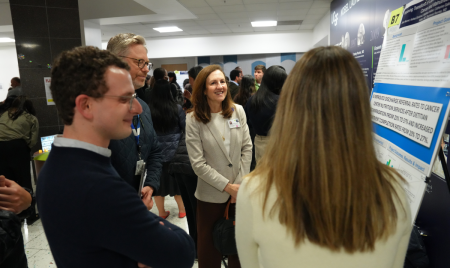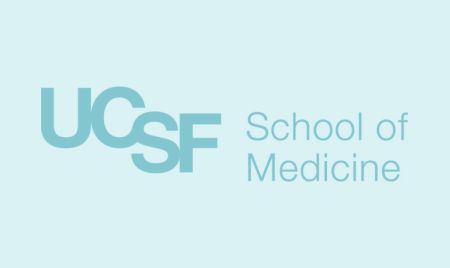Walking tours of San Francisco: Teaching medical students to care for patients in diverse communities

walking tours
Read on for a story by third-year medical student Marci Rosenberg. Learn more about the UCSF Alumni's programs that help train medical students to care for patients in the City's diverse communities.
When I moved to San Francisco to start medical school, there were a few essential geography facts I learned quickly. The first was that the city is small (well, at least if you count by square miles, and not by population). The second was that, even within that scarcity of surface area, San Francisco is packed with tightly defined neighborhoods, each with their own unique community and rich history. One of the joys of training at UCSF School of Medicine is being given the opportunity to hone our clinical skills at a broad array of sites across San Francisco and the greater Bay Area.
In practice, this means that students interact with patients who come from diverse neighborhoods and communities. While this range of clinical experiences is a great strength of medical education at UCSF, it also means that I am sometimes fumbling to provide accurate, appropriate guidance to patients who live in communities I am unfamiliar with. As a San Francisco transplant, this is a particularly poignant problem, given the potential for vast misalignment between the gentrifying Mission I bike through and the Mission my patient envisions when she thinks of “home.”
One UCSF alumnus, Marilyn Wong, MD (Class of 1986), is attempting to address this problem by spearheading an initiative to create “Insider Tours” of San Francisco neighborhoods for health professional students. While Dr. Wong has been contemplating this idea for some time, it was a conversation with a few first-year medical students that really helped push the idea into reality. As Shakkaura Kemet, one of those medical students, explains, “I met Dr. Wong when she was giving out white coats [in preparation for the UCSF School of Medicine’s 2017 White Coat Ceremony]. We bonded over the fact that we had both done MPHs, and she said she was interested in setting up tours of different neighborhoods of the City to help students get a broader context of understanding the populations we serve.”
A few weeks later, Kemet and two other first-year medical students attended Dr. Wong’s first pilot walking tour of Chinatown. The tour started with a guided exploration of exhibits in the Chinese Historical Society, covering such topics as the history of Chinese immigration to the U.S. via San Francisco, as well as the political history of the neighborhood. This was followed by a walk through the streets of Chinatown, during which the students got a better appreciation for both the culture and health resources of the community.
Information imparted on these tours has the potential to have real, tangible impact on students’ interactions with patients. For example, Margot Pierluissi, another first-year medical student who attended Dr. Wong’s first tour, learned that “Chinatown is one of the only neighborhoods that has a significant portion of the population living below the poverty line, but also is not a food desert.” This means that while many residents of Chinatown have restricted disposable incomes, they also have access to grocery stores and farmers’ markets that sell fresh produce.
With this information in mind, Margot would ensure she chats with Chinatown-residing patients about where they’re purchasing groceries and the kinds of food they’re eating; in this patient population, dietary choices would be a place that physicians could have a meaningful effect on health outcomes. Dr. Wong strongly agreed with the idea that gaining more detailed knowledge about the past and present of a community would benefit physician-patient relationships by improving the specificity of a physician’s advice and recommendations. To illustrate this point, Dr. Wong discussed housing in Chinatown, where many residents live in single room occupancy units (SROs). “In SROs, there are shared bathrooms,” Dr. Wong explained. “When we give the advice, ‘you should be soaking your feet,’ I would know, for someone who lives in an SRO, that [such advice] may be a challenge, just because he can’t stay in the bathroom for a very long time, as the whole floor is going to be needing it.”
Dr. Wong has since given a second tour of Chinatown to a handful of medical and pharmacy students, and explains that her goal is for “students to be able to walk away with that historical context, when we look at whatever comes, be it a patient, [or] the latest thing in the news.” And the benefits of a program like this are not only limited to enhanced student awareness and improved student-patient communication. Fiona Ng, a first-year medical student who participated in Dr. Wong’s second tour, disclosed that “The value of going on a tour with an alumnus [is that it] really helps [me] to see what I can do in the future… it felt like I found a role model [in Dr. Wong]; [like me], she came to UCSF for medical school, she grew up in San Francisco, she got an MPH… that sounds like what I want to do too! It’s nice to know that there’s a resource I can go to.”
If you are an alumnus/a who might be interested in giving your own “Insider Tour” of a San Francisco neighborhood this September as part of the first year medical students’ orientation, please reach out to Katie Maloney, the Senior Director of Alumni Relations, at [email protected], by July 1.
And for those considering this opportunity, let me leave you with this thought from Dr. Alex Smith (MD ‘02), the president of UCSF’s Medical Alumni Association: “If you have some insider knowledge about a San Francisco neighborhood, you have an important contribution to make! Students are thirsty for these experiences: both in terms of the knowledge gained and the contact with ’real world’ practicing physicians and UCSF Alumni. This is an important way to give back.”









